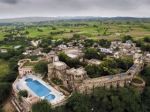
The rise of luxury homestays in India
Curated and tailormade experiences, locally sourced food, privacy, and even a brush with history are becoming the hallmarks of luxury homestays in India
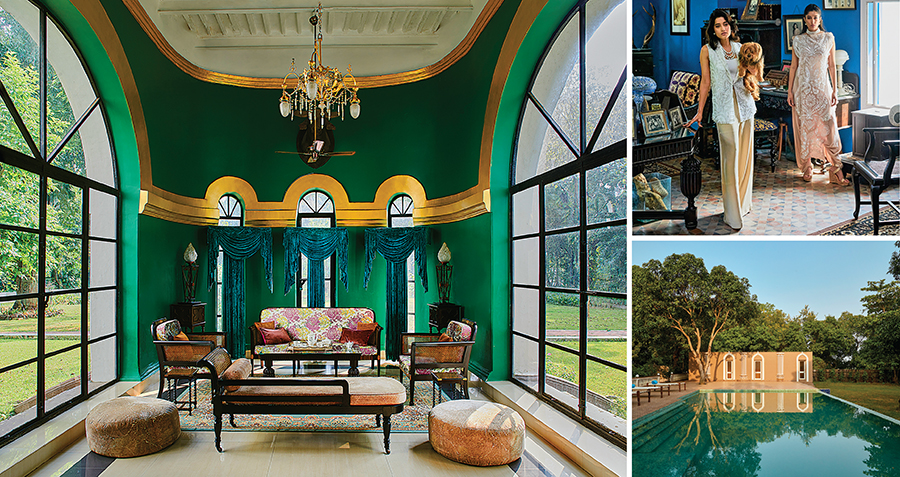 (Clockwise from left) The Belgadia Palace has 10 living areas, apart from 15 bedrooms as part of the homestay; Akshita and
Mrinalika Bhanjdeo; the swimming pool
Image: Courtesy The Belgadia
(Clockwise from left) The Belgadia Palace has 10 living areas, apart from 15 bedrooms as part of the homestay; Akshita and
Mrinalika Bhanjdeo; the swimming pool
Image: Courtesy The Belgadia If the devil can be in the details, then, as French fashion designer Hubert de Givenchy had said, luxury too is in each detail. Although his thoughts were with reference to haute couture—him being the professional and personal designer to style icons such as Audrey Hepburn and Jacqueline Kennedy—they can easily be applied to hospitality as well. Take, for example, the detail that the room you are sleeping in has a history that goes back a few centuries, or the detail that your breakfast marmalade, and the toast you are smearing it on, have been made by hand from locally sourced, chemical-free ingredients on the same property you are staying at, or perhaps the detail that you are the only occupants of an entire property, with no one to trespass on your time and space as you recede from the hustle of city life for a few days.
If luxury hotels, with their opulent interiors, gourmet cuisines and signature services, have been the mainstay of high-end hospitality for decades, then luxury homestays are now coming of age in India, offering exotic locations, curated services and food, and generous dollops of history and heritage.
“Staying at The Belgadia Palace transports guests back in time,” says Akshita Manjari Bhanjdeo, the 48th generation of the erstwhile royal family of Mayurbhanj in Odisha. “The property was commissioned by Maharani Sumitra Devi in the late 1700s, and it first started being built in 1804. It was built to be a home for foreign dignitaries who came to visit the royal family on diplomatic missions. So, in that sense, it was always supposed to welcome global travellers, statesmen and leaders. A lot of iconic people from history have stayed at the palace. We haven’t even changed the furniture or the style of upholstery. So, the desk in your room could well have been used by some famous dignitaries of the past.”
The Bhanjdeos—Akshita and sister Mrinalika being the youngest members— have been part of Mayurbhanj since 697 AD, and had moved into Belgadia as their primary residence post-Independence, after having decided to donate all their other properties in Mayurbhanj, Kolkata and Shillong for the purpose of establishing educational institutes. At The Belgadia Palace, apart from the two wings in which the family lives at present, there are 15 rooms that are part of the homestay, with about 10 additional leisure rooms, such as libraries, living rooms and salons; tariffs vary between ₹16,000 and ₹27,000 per night.
The biggest changes that had to be incorporated to adapt this Victorian era structure to modern-day requirements included the wiring, plumbing and electricals. “Conserving and restoring the property was very important, and so we had to dig up the history of how the house was made, and use more natural and sustainable materials. We wanted to ensure that when someone visited Belgadia, they were transported back in time, but still had access to any of the amenities they would find in any modern, cosmopolitan city in the world,” says Bhanjdeo.
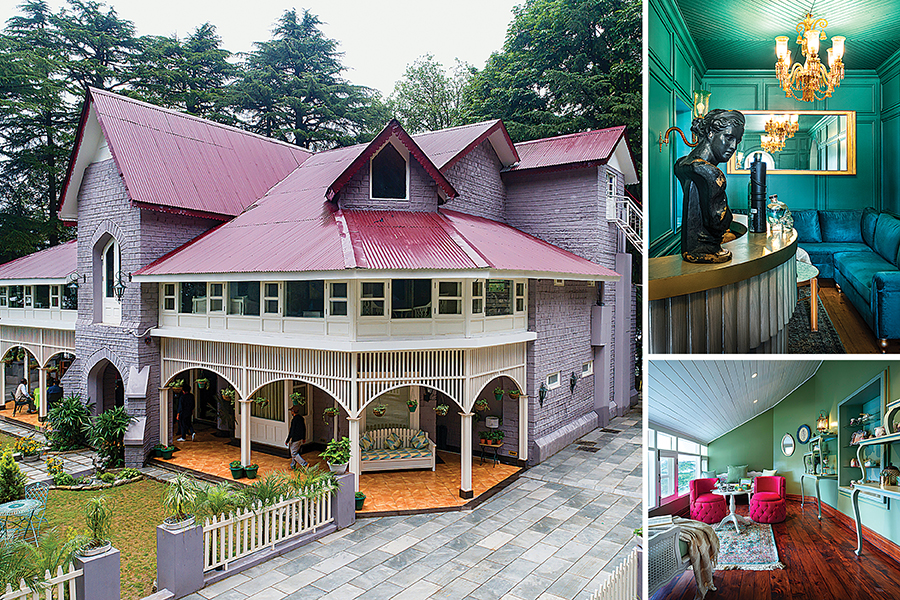 The Elgin was the summer house of the Khurana family. Its interiors were carefully restored to provide all modern facilities while retaining its heritage
The Elgin was the summer house of the Khurana family. Its interiors were carefully restored to provide all modern facilities while retaining its heritageAdapting a heritage property to modern times was a challenge that Kavish Khurana also faced, while converting his family’s summer home in Dalhousie into a homestay called The Elgin. “The property has been in our family since 2000. My parents would visit Dalhousie, and stay there for two to three months. Our family has been very attached to Dalhousie for the last, maybe, 50 years. My granddad never went anywhere else in summer; for him, it was just Dalhousie.”
The Khuranas decided to convert the house into a homestay in 2018, because there were no good hotel properties in Dalhousie for visitors from the metros. “Visitors would not really think about going to Dalhousie because there were no brands, no good properties. Since this is a heritage property, we decided to convert it into a luxury homestay. Other brands have popped up after we opened in 2020.” The fact that demand has gone up is reflected in the tariff, which started at ₹7,500 when The Elgin opened its doors, and has since been increased to ₹14,000 to ₹15,000 per night.
Khurana has been hosting a niche clientele of high net-worth individuals from Delhi, Mumbai and Bengaluru to the seven-bedroom property. “Post Covid, guests are looking at properties with fewer rooms. And even if they are using four rooms, they will book all seven,” he adds. “We also prefer to give out the whole property to one individual or group. This would not be possible at bigger properties, either for the guest or for us.”
Whenever there is a booking, Khurana makes it a point to be in Dalhousie—“since The Elgin has only seven bedrooms, it is not always possible to stay there when guests have booked it, and I am booked into another hotel,” he explains—to look into the guests’ needs and customise food and services according to their requests.
Also read: Can India become the next China for the luxury market?
Converting the family home to a homestay included restoring its interior decor, floorings and ceilings, while putting in modern amenities. “Very few changes have been made, so that guests feel they have travelled back in time, some 80-90 years. This is very different from most properties nowadays, which are very modern. We get calls from guests asking if we have something like The Elgin in other cities, so that they can have the same experience there. I have been looking for a property like this in Amritsar, but everyone demolishes their old homes instead of restoring them.”
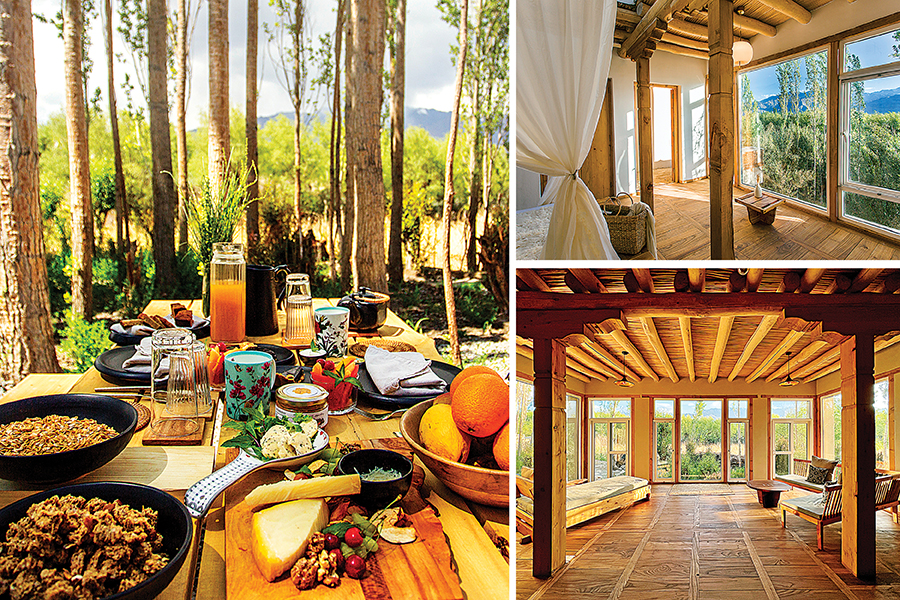 Shel Ladakh was built using traditional, local techniques, while incorporating contemporary elements such as insulated glass for its full-length windows Image: Courtesy Shel Ladakh
Shel Ladakh was built using traditional, local techniques, while incorporating contemporary elements such as insulated glass for its full-length windows Image: Courtesy Shel LadakhAlthough Jigmet Wangchuk was one such person to pull down his family’s property in Shey, Ladakh, he repurposed the same material—wood and mud bricks—and brought in more of the same, to rebuild it into Shel Ladakh, a three-bedroom homestay. “It took us a good five to seven years to make it and it’s fully localised, made of mud bricks, so that it blends in with the ancient techniques of construction in Ladakh. These techniques are meant to survive this kind of climate,” says Wangchuk.
“So, we’ve combined these sustainable elements with new, modern elements that can make it very comfortable. The winters here are very harsh, so the whole house is vertical and faces the south to allow a good amount of sunlight to enter throughout the day. This is not a city house, but has all the comforts of a city house within a localised house,” he explains. “For instance, earlier, homes had small windows, because they were meant to keep the cold out. But now, with the availability of insulated glass, we have the opportunity to build full-height windows, which is what we have.”
The minimalist interiors are a reflection of the stark beauty of Ladakh’s landscape, while privacy is the overarching theme. “We have three bedrooms, apart from living areas. But even if you book one bedroom, we don’t give out any of the other rooms on the same dates. So, essentially, you will be the only guest on the property,” adds Wangchuk. The tariff for two people is ₹50,000 if they book one bedroom, ₹75,000 if they book two rooms, and ₹95,000 if they book three. “This includes everything such as bonfires, barbeques, sparkling water, and custom-made food requests,” he adds.
Wangchuk lives close by with his family, and, in keeping with the theme of privacy, interacts with guests only if the latter wish to. “We don’t intrude on their space, unless they would like to meet us.” A stone’s throw from the property is the Indus river and the Shey marshes, a haven for birdwatches, along with ancient monasteries.
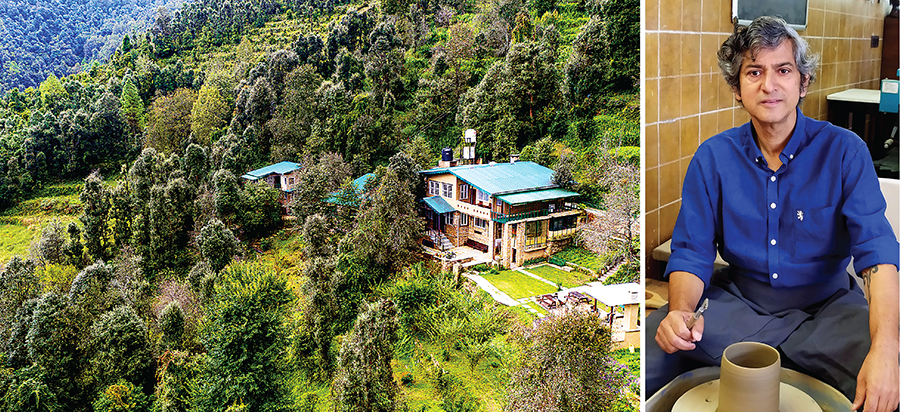 Guests at the Himalayan Homestead can take walks in pristine oak forests surrounding the homestay, or take part in therapeutic pottery sessions with founder Yogesh, for which he uses local clay
Image: Courtesy Himalayan Homestead
Guests at the Himalayan Homestead can take walks in pristine oak forests surrounding the homestay, or take part in therapeutic pottery sessions with founder Yogesh, for which he uses local clay
Image: Courtesy Himalayan HomesteadLocalised construction, chemical-free food that is grown and sourced locally, and being close to nature is what the Himalayan Homestead, in Uttarakhand’s Kalapatal, is also about. “What comes to mind when you think ‘high-end’ with regard to the city? That is not what we had in mind when we came here. We are in a forest, where you need to walk about 500 m from the gate once you have parked your car,” says Yogesh, co-founder of Himalayan Homestead, a five-cottage property. “We planned this place in such a way, that everything we used has either been physically carted up or constructed on site. So, the idea of luxury had to be very area-specific.”
Consequently, everything that is served from the kitchen of the homestay is made inhouse with the produce of the land, while the workers and porters on the property all understand what the guests are looking for in a place like this. “They are trained for guests who are not looking for a Taj, or an ITC or a Welcome Group hotel,” says Yogesh, who stays on the property along with wife Namita. “All our rooms are well-ventilated and sun-fed, facing the Himalayas. They are comfortably luxurious, using linen that is dyed organically. So, what you sleep and sit on is as natural as it can get.” Charges for the cottages vary between ₹7,000 and ₹12,000.
Taking its guests closer to nature, quite like the Himalayan Homestead, is the School Estate in Coorg. Not quite an oak forest, but guests can explore a 200-acre estate with coffee, pepper, cardamom and areca nut plantations, home to native and rare trees and dozens of bird species. “The School Estate homestay is 25 years old, and is owned by KK Aiyapa and Rani Aiyapa, owners of the plantation,” says Shashidhar, who has been managing the homestay for nine years now.
The plantation bungalow was built in 1878, and was home to Reverend Georg Richter, a German missionary who came to India in the mid-19th century. “The Aiyapa family got the property from Reverend Richter, and they live here as well and interact with guests at the homestay,” adds Shashidhar. Apart from German architectural influences, several other artefacts from Richter’s time have lived on at the property, which has two cottages, two twin-bed rooms and one family accommodation, which cost around ₹17,700 per night. While before the Covid-19 pandemic, 75 percent of guests at the homestay were from Europe, post-Covid, there has been an increase in the number of India guests from Mumbai, Pune, Delhi, and Bengaluru.
Also read: Living that luxe life: Around the world in a private jet
Hyperlocal experiences
All guests at The Belgadia Palace have their meals and experiences curated and tailor-made for them; “it is something that differentiates us from other properties, as we take a lot of time to understand our guests,” says Bhanjdeo.One of the three things that she recommends for guests is a Mayurbhanj Chhau performance. The second experience is a curated visit to a Sabai grass handicraft cluster; according to folklore Greater Mayurbhanj is the only place where Sabai grass was planted by the family’s ancestors. The third thing is a birdwatching tour inside the Similipal Tiger Reserve.
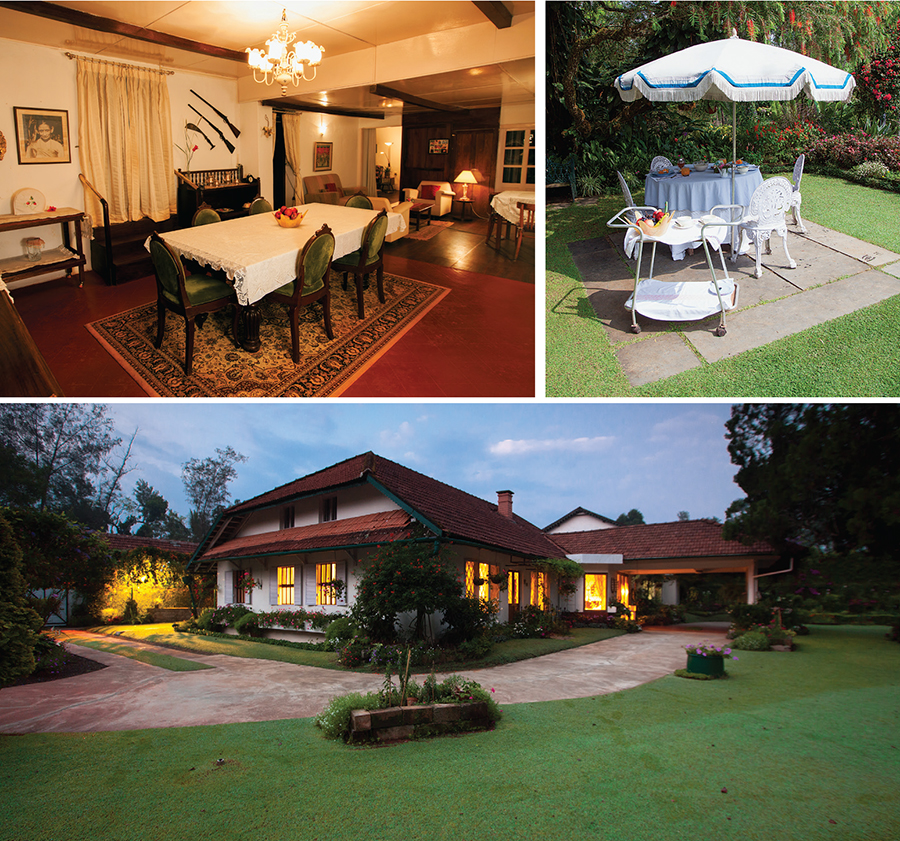 The 100-year-old pool table has been converted into a dining table at the School Estate, where guests can enjoy al-fresco dining, or take a walk around 200-acre plantation
Image: Courtesy School Estate
The 100-year-old pool table has been converted into a dining table at the School Estate, where guests can enjoy al-fresco dining, or take a walk around 200-acre plantation
Image: Courtesy School Estate Guests are also taken to the old town of Baripada, which is home to more than 5,000 historical sites. “We have the oldest museum of the state, the Baripada Museum and the Kiching Museum. The royal family had established an archaeology department, long before the Archaeological Society of India was born.
Guests can take a look at Kushan era coins, which are in the British Museum as well, donated by the Mayurbhanj royal family, palm manuscripts from the Mughal era, and such other artefacts. The idea is to understand these heritage cities and what existed in pre-colonial days, to give an idea of what India was in the medieval period.”
Guests can experience centuries-old temple rituals, which the Bhanjdeo family has preserved, listen to stories of the family and its ancestors, preserved in books, diaries and heirlooms. “For a lot of guests, the number one request is a property tour, because it’s extremely detailed,” says Bhanjdeo. She had her sister host the tours, speak to guests over tea, and share stories about the family and property.
Guests also get a sumptuous taste of royal recipes, such as Moori Mangsho and Induri Pitha, and the local Chhana Pora. “We prepare a lot of recipes that have been passed down within the family; there is the coastal cuisine as well. Guests especially appreciate the Kansa and terracotta tableware in which the food is served.”
If history and heritage are the highlights of the food at The Belgadia Palace, then organic, locally sourced food is what takes position of pride on the tables of the Himalayan Homestead. “It’s our food that we really stress on: It’s natural, organic and local. Taste is not compromised for a healthy meal,” says Yogesh. “Namita is a food curator, and recipe inventor and ensures that the menu is curated according to the clients’ tastes and sensibilities. There is no one menu that fits all. All our jams, marmalades, preserves, crackers, pickles, cookies and chocolate are made with the best quality ingredients, and lots of love at the homestead.”
Fusion chocolates are a big hit with guests at Himalayan Homestead, which use no colour or preservatives, and includes only organic fruits from its orchard. “We do not spray or use pesticides on our vegetables and fruits. So, even the grass you sit on is clean and natural,” he adds.
“Our guests are those who have seen it all and had it all, and want simple, tasty and organically sourced food; food that is not taxing for the system. Even the water that is offered to the guest is from an age-old naula and no open running water.”
Guests can trek into the nearby oak forest—an undisturbed, intact woodland with its indigenous variety of flora and fauna—for taking a dip in the mountain waters, or go through therapeutic baking and pottery sessions with Namita, an expert baker and food critic, and Yogesh, an experienced potter. “For pottery we use local clay, which is good for the hands and environmental,” he adds.
Most of what you will be served at the tables of The School Estate also comes from the plantations, whether it be the spices that are used in the traditional Kodava preparations, or the milk and cream that comes from the estate’s cows, or the freshly brewed coffee that comes beans grown at the plantation.
The definition of luxury, as exemplified by these homestays, is a variable. While to some it might mean sleeping in the same bed as a king from a century ago, to others it might mean the ability to savour the tranquillity of seclusion. But despite these varying interpretations of luxury, what remains constant—predictably so—is the fat price tag it comes with.
(This story appears in the 17 November, 2023 issue of Forbes India. To visit our Archives, click here.)
Post Your Comment



